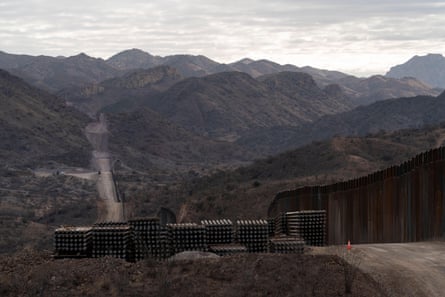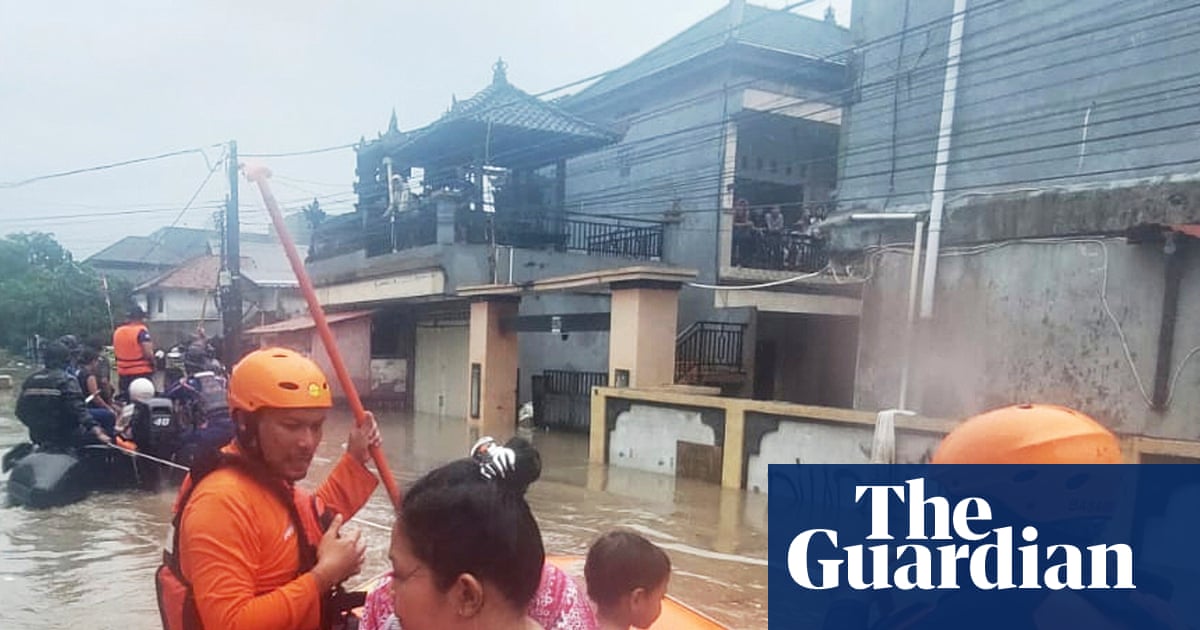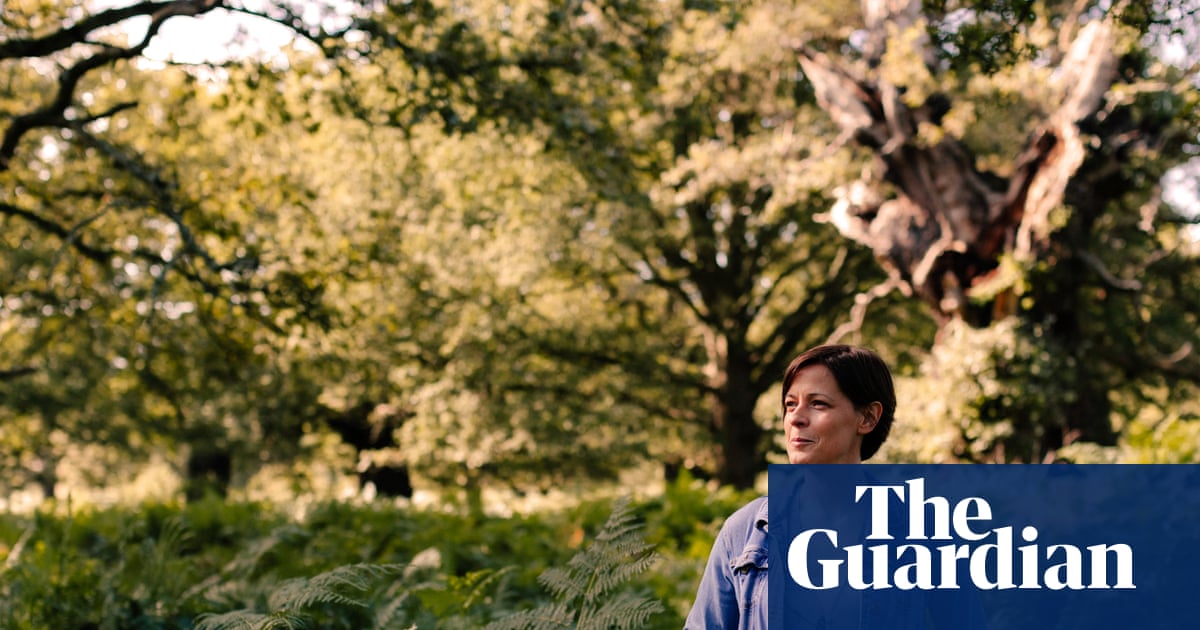Donald Trump is forging ahead with a new section of border wall that will threaten wildlife in a remote area where many rare animals – but very few people – roam.
Customs and Border Protection (CBP) has invited private sector companies to bid for contracts to erect nearly 25 miles of barrier on the US-Mexico border, across the unwalled south of Tucson, Arizona, one of the most biodiverse regions in the US.
Here, vast rolling grasslands stretch across high desert, hemmed in to the east and west by rugged, isolated mountain ranges known as sky islands because they rise abruptly and spectacularly out of the arid flatness.
“This is a crucial wildlife corridor,” said Eamon Harrity, wildlife program manager for the Sky Island Alliance, a conservation non-profit, while driving along a dirt road towards the cottonwood tree-lined Santa Cruz River that flows towards Mexico.
A nearby motion-triggered wildlife camera, one of 65 operated by the alliance just in this section of the border, where there is a lengthy gap in the barrier, captures thousands of images of wild animals, including bears, bobcats, pronghorns and mountain lions.
“Large predators and other animals move freely through this landscape,” said Harrity, as he replaced the batteries of a trail camera pointed toward the wide open-landscape that, on a map, would show the border with Mexico. Harrity assists in monitoring more than 110 cameras across a wider area for an alliance study that began in 2020 to record the effects of Trump’s barrier on cross-border movements for local wildlife.
“That [movement] won’t happen once the wall is complete,” he added of that stretch of the Arizona-Mexico border.
That completion now looks set to become a reality. “CBP is soliciting bids for construction of 24.7 miles of border barrier around International Boundary Monument 102 in the Sonoita Border Patrol Station area of responsibility,” a CBP spokesperson told the Guardian in an email, referring to the small stone obelisks, or monuments, that have traditionally been dotted along the international line.
Outside the San Rafael valley, the stretches of border wall designed to keep people out of the US with 30ft-high steel posts spaced just four inches apart are impassable to anything larger than a jackrabbit, the speedy, long-legged hares typical of the area. Once this valley is walled, too, it will sever a critical wildlife corridor for animals migrating between Mexico and Arizona.
Erick Meza, borderlands coordinator for the Sierra Club environmental advocacy group, said walling the valley would be “catastrophic for the environment and wildlife”.
On 27 April, the US House of Representatives homeland security committee unveiled its proposed budget, allocating $46.5bn to fund new chunks of barrier on the almost 2,000-mile US-Mexico border, where building a wall was a focus and highly vexed issue in the first Trump administration and is far from complete.
The new push for more wall comes as unauthorized crossings by people migrating to the US through or from Mexico had been falling fast last year after Joe Biden tightened restrictions and have now reached historic lows. This was noted by CBP and trumpeted with inflammatory language by the Trump White House, even as the president spoke of “invasion”.
“Even when numbers were the highest, people were crossing in areas that already had a border wall,” said Meza. “San Rafael valley never saw those numbers.”
Critics are furious.
“It’s an expensive, unnecessary, and environmentally disastrous project,” said Harrity of the barrier, which can cost up to $30m per mile. “If completed, this wall will sever a continent.”
Successful legal challenges to federal actions on the border can be difficult, but opponents are intensively researching their options.
And tall metal boundaries, which not only impede animals but, when under construction and being patrolled, cause huge damage and disruption, are not the only worry for wildlife advocates. Trump has also announced a plan to further use the military and take over vast swaths of public lands along the border.
A presidential memorandum in April directed the transfer of a 60ft-wide strip of federal land running along the border in California, Arizona and New Mexico, known as the Roosevelt reservation, to US military control.
That could mean new military bases and staging areas which, state actions in Texas have shown, create environmental havoc.
Myles Traphagen, borderlands director for the Wildlands Network, is concerned that large military facilities could be constructed in the region, further enhancing the human footprint of an already militarized border.
“It’s an invasion,” said Traphagen. “An invasion of our public lands.”
Mark Nevitt, an Emory University School of Law professor, said the president appeared intent on an unprecedented use of “national security language associated with executive power, [such as] ‘invasion’ and ‘under attack’, that appears to expand the military’s role in immigration enforcement”. He also fears that Pentagon funds will be funneled into more wall building on land to be designated as “national defense areas”.
Noah Schramm, border policy strategist for the American Civil Liberties Union of Arizona, called the intended step-change in militarization “uniquely alarming” and warned that troops could be used to apprehend migrants and civilians alike for allegedly illegally entering a restricted military area

In Arizona, 63% of the border has already been sealed off and the remaining open sections are critical for wildlife, with the San Rafael valley being one of the last intact expanses of Sonoran desert grasslands in the state. The area’s rugged Huachuca and Patagonia mountains, part of the Sky Island range, serve as stepping stones across a harsh desert by offering a range of habitats, food sources and water for animals.
“The biodiversity here is incredible,” said Meza, of the Sierra Club. As well as bears, mountain lions and wolves there are subtropical species such as the wild pig-like javelina, and rare big cats – ocelots and jaguars, with natural ranges of hundreds of miles between countries in search of food, water and mates.
“This is at the heart of all these different ecosystems coming together,” Meza added.
As Harrity of the Sky Island Alliance drove his battered red pickup through the wilderness he passed a lone pronghorn, the strange, antelope-like creature that is the fastest land mammal in the Americas. The San Rafael valley was entering year three of a severe drought, he said.
“When it rains, it can look like Scotland,” he said. In dry times like now, the valley looks more like the African savanna, with rolling hills of native grasses awash in soft yellows, oranges and rusts. “A study in browns,” he added, bouncing along toward the only greenery visible – cottonwood trees lining the Santa Cruz River.
Harrity said that as the climate crisis exacerbates drought in the south-west, wildlife in the border region will need to range farther and farther seeking food and water. In 2021 a Mexican grey wolf known as Mr Goodbar paced 23 miles along the border wall searching for a place to cross into Mexico. After days, he finally gave up and returned to the Gila wilderness area in New Mexico.
“The last thing we should be doing right now is walling off corridors and severing connectivity,” Harrity said.
The Santa Cruz River is a vital animal migration corridor that meanders into Mexico and back to Arizona. “The river will now be walled on both legs of its journey,” said Harrity. A nearby wildlife camera recently captured a video of a mountain lion carrying its prize, a dead coyote, into Mexico.
The valley is almost devoid of people. And it lacks the telltale signs of migration in the borderlands: ripped clothes on bushes, discarded backpacks and empty water bottles. In five years, a camera by the river has never captured an image of a migrant crossing into the US, even though it’s one of the few parts of the valley with shade and water.
On a hill above the river an agent in a white and green border patrol SUV looked on.
Then in New Mexico, to the east, near the small town of Columbus, Traphagen of Wildlands Network pointed from a hilltop brightened by red-flowered ocotillo plants to the longest contiguous section of border wall in the US. Eighty miles of three-story-high posts cutting through sand dunes and volcanic hills like a giant serpent, all the way to El Paso, Texas.
As the spring wind picked up, the steel pillars began to reverberate and hum. “When the wind really gets going, it sounds like Tuvan throat singers,” said Traphagen of the central Asian singers who can produce a low vocal rumble and a high whistle-like tone at the same time.
Many of the Wildlands Network’s trail cameras are pointed toward “construction anomalies,” said Traphagen, where posts have been mistakenly placed five or six inches apart instead of the usual four. Those extra 2ins do not affect human crossing but can allow animals, such as javelina and coyotes, at least, to pass through. That subtle difference would also reduce the number of posts needed to build the hugely expensive border wall. “That’s probably $30m worth of steel there,” said Traphagen, pointing in passing to an abandoned construction staging area from the previous Trump administration containing thousands of steel pillars stacked like the kids’ building toy Lincoln Logs.
Other trail cameras are placed near open floodgates, resulting from a 2023 lawsuit requiring the border patrol to open intermittent gates in the barrier to allow larger animals to pass.
“This camera has captured over 1,000 videos, and we have never seen a person crossing through,” said Traphagen. It points along a sandy wash marked with the paw prints of rabbits, coyotes and badgers. Of the eight cameras checked during one long outing at the New Mexico border, only one had captured any evidence of migrants.
But in a 2024 study by the Wildlands Network and Sky Islands Alliance, motion-activated cameras along 100 miles of walled border showed an 86% decrease in wildlife crossings and a 100% reduction for animals such as wolves, bears, pronghorns, and jaguars.
“The Trump administration would rather score cheap political points and a favorable Fox News headline than solve a problem. Instead of wasting taxpayers’ dollars, undermining military readiness and jeopardizing American families’ safety, Trump and [Elon] Musk should focus on actually fixing our broken immigration system,” said Martin Heinrich, US senator for New Mexico and a Democrat.
“New Mexicans who live on the border want actual solutions, like creating new legal pathways for immigration, investing in effective border security for law enforcement, and addressing the root causes of mass migration,” he added.
Back in the San Rafael valley, Traphagen noted that, on top of everything, parts of the original 1955 movie of the musical Oklahoma! were filmed in this beautiful spot.
“It will be a tragedy to see a pristine grassland … turned into a military zone,” he said.

 3 months ago
105
3 months ago
105

















































